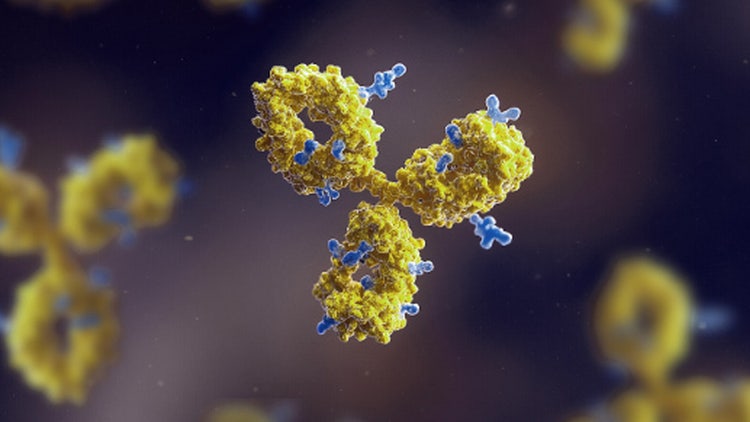Comprehensive Characterization of ADCs Using EAD Peptide Mapping and icIEF-UV/MS

Dr. Jingwen Ding, Sr. Technical Product Manager - SCIEX, shares her expertise in developing and refining icIEF-UV/MS workflows to address the need for reliable charge heterogeneity information. She discusses leveraging icIEF-UV/MS and electron-activated dissociation (EAD) peptide mapping for multilevel characterization of conjugation end products to advance antibody-drug conjugates (ADC) research and the development of high-quality drug products.
1. What are the key challenges in characterizing next-generation ADCs and other complex biotherapeutics?
Some challenges the market is currently facing with biotherapeutic characterization are the need for rapid charge heterogeneity and impurity assessment for structurally diverse ADCs. Another challenge our customers face is the characterization of labile post-translational modifications (PTMs) and the drug payloads, especially for the ADCs, since they're critical for this new generation of therapeutics. When doing the characterization, you often use different platforms and analysis assays from various vendors. So that's really increasing the investment in resources and the length of the development cycles.
2. How does the SCIEX Intabio ZT system enhance biotherapeutic characterization, particularly for complex molecules like ADCs?
The Intabio ZT system is designed for rapid charge heterogeneity analysis and can be used for your stability studies and purity assessments. The ZenoTOF 7600 system, integrated with the Intabio ZT system, has EAD as its most distinctive feature. The advantage of EAD is that you can localize your labile PTM and your drug payload. It also differentiates isomers, and you can do your disulfide bond mapping or sequence variant analysis.
The Intabio ZT system, when integrated with the ZenoTOF 7600, enables front-end icIEF separation, which will separate your proteoforms according to their isoelectric point for precise charge heterogeneity profiling. A few advantages of icIEF UV/MS analysis are that it can comprehensively measure the intact heterogeneity without time-consuming fractionation, which helps reduce your development risk and accelerate compound understanding. The system also offers early insight into PTMs and payloads to guide you through your target bottom-up analysis methods.
For example, if you think about deamidation and its subtle 1-Dalton mass shift, this can be confidently detected due to its distinct acidic charge shift. With a traditional RPLC method on the intact level, you will never have the confidence to say that you have the deamidation in the sample. But with the charge separation in the front-end, you can actually see the deamidation. Additionally, this analysis method can really be used for different sizes of molecules and different modalities, from 10K to 300K Dalton, including bispecifics, trispecifics, fusion proteins and ADCs. Overall, our integrated system simplifies workflows and increases your confidence in intact-level result analysis.
3. What does icIEF-UV/MS analysis reveal about the synthesized trastuzumab MMAE conjugate?
The icIEF-UV/MS workflow provides detailed characterization of the trastuzumab MMAE conjugate, which is synthesized through a three-step reaction involving deglycosylation, activation and conjugation. The UV profile shows that conjugation introduced an acidic shift of the main peak from pI 8.93 to 8.56, confirming successful conjugation. Additionally, the UV peak quantitation for each acidic and basic group shows changes in the abundance of these species. So, when looking at the MS profile for trastuzumab and the ADC conjugate, this shows that we're able to maintain the separation resolution we have established during focusing and carry it all the way to the mass spec so that we have the confidence to really identify what each charge variant is. The data shows that these systems provide high-resolution separation, sensitive detection and confident identification of charge variants across a wide range of molecule types and sizes.

4. How do ZenoTOF 7600 systems and orthogonal workflows support the comprehensive analysis of trastuzumab and its ADC conjugates?
The Intabio ZT system monitors modifications that introduce shifts in isoelectric points, including terminal modifications, glycosylation, glycation, and deamidation. EAD peptide mapping with the ZenoTOF 7600 system provides good sequence coverage, and further confirms and localizes the modifications observed on the intact level. With EAD capability, we can see the labile PTMs, for example, differentiating between the aglycosylated and glycosylated species. Biologics Explorer software provides quick visualization of the sample, including glycoform clusters and terminal modifications like unclipped lysine and PyroQ.
The ADC analysis revealed a simpler deconvoluted mass map due to the N-glycan being closed off during conjugation. This allowed us to identify two main drug-to-antibody ratio (DAR) species: DAR2 (97.8%) and DAR1 (2.2%). The EAD enabled precise localization of fucosylation variants within DAR2, while DAR1 species were traced to incomplete conjugation steps or aglycosylated heavy chains lacking conjugation sites. With peptide mapping, we were able to confirm the original regions of the DAR1 species. We showed that structural variants and modifications were carried into the ADC from the trastuzumab. This orthogonal streamlined icIEF-UV MS workflow and EAD-based peptide mapping allows confidence in assignment beyond traditional workflows, such as fractionation and CID-based peptide mapping.

Check out the full webinar for an in-depth look at an analytical approach for complex therapeutics, with a focus on detailed characterization and precision to deliver a consistent, high-quality drug product.

Characterizing Antibody-Drug Conjugates Through Innovative Analytical Solutions
